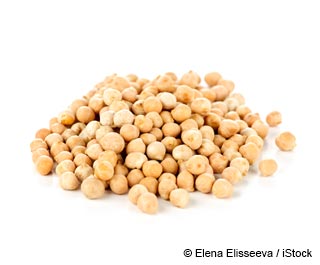Garbanzo Bean Goodness
Botanical name: Cicer arietinum

It's been around 7,500 years since garbanzo beans (also known as chickpeas) spread from Turkey to the Middle Eastern, South Asian and North African regions,1 but they weren't cultivated until about 3,000 B.C. By the 16th century, Spanish explorers spread the love for this food's nutty, buttery taste and slightly grainy texture beyond Rome and Greece.2 Today, India, Pakistan, Turkey and Mexico are some of the largest producers and consumers of garbanzo beans.3,4
There are two main varieties of garbanzo beans available: kabuli and desi. The large, smooth and beige-colored kabuli is more widely available than the smaller, darker and rough-skinned desi, which are also split and sold as “chana dal” in India.5 Garbanzo beans also come in green, red, brown and black colors.6
One major caveat about garbanzo beans is that they contain lectins,7 which are sugar-binding plant proteins that bind to the cell membranes. Studies show that excessive consumption of lectins results in poor digestion, nutrient deficiencies and intestinal damage, ultimately increasing your risk for autoimmune diseases, hence why you should limit your consumption of lectin-containing foods.8
Preparing and cooking garbanzo beans properly helps reduce their lectin content. Soak the chickpeas in water for at least 12 hours, and be sure to change the water frequently. You can also add baking soda to further neutralize the lectins. Discard the soaking water and rinse the chickpeas before cooking them for at least 15 minutes on high heat or using a pressure cooker.
Health Benefits of Garbanzo Beans
Garbanzo beans are low in saturated fat, cholesterol and sodium, and are an excellent source of folate,9 a vitamin that plays a role in amino acid synthesis, vitamin metabolism and DNA replication.10 They also contain manganese,11 which may help promote healthy metabolism, bone formation, reproductive function and immune response.12 Garbanzo beans are a good source of dietary fiber,13 which may help lower your LDL cholesterol and blood sugar levels.14
According to the journal Nutrients, garbanzo beans are rich in various bioactive plant compounds, including “sterols, tannins, carotenoids and other polyphenols such as isoflavones.”15
Despite these benefits, studies show that garbanzo beans also contain high amounts of antinutritional factors like phytic acid and oxalates, in addition to lectins. According to a 2018 study published in Food Research International, 100 grams of chickpeas may contain between 92.2 and 214 milligrams of oxalate,16 which can bind calcium and other minerals and increase your risk for developing stones in the urinary tract.17 To learn more about the nutritional value of garbanzo beans, check out the table below:18
Garbanzo Beans Nutrition Facts
Serving Size: 3.5 ounces (100 grams), mature seeds, cooked, without salt
| Calories |
164 |
|
| Total Fat |
2.59 g |
|
| Saturated Fat |
0 g |
|
| Trans Fat |
|
|
| Cholesterol |
0 mg |
|
| Sodium |
7 mg |
|
| Total Carbohydrates |
27.42 g |
|
| Dietary Fiber |
7.6 g |
|
| Sugar |
4.8 g |
|
| Protein |
8.86 g |
|
| Calcium 49 mg |
Iron |
2.89 mg |
Studies on Garbanzo Beans
A study published in European Food Research and Technology evaluated the effects of different pre-cooking methods on the carbohydrate and antinutrient content of garbanzo beans. The results show that soaking the chickpeas in water may help reduce their carbohydrate content by 19% to 20%. Soaking and cooking, on the other hand, may help reduce their carbohydrate content by up to 24% and their alpha-galactosides by up to 27%, while eliminating trypsin inhibitor activity.19
Moreover, in the same study, researchers also found that soaking garbanzo beans may help decrease their lectin content by 0.11% to 5.18%, as well as reduce their total and soluble oxalate levels.20
When prepared properly, a study shows that garbanzo beans may provide beneficial effects on various human diseases, including cardiovascular disease, Type 2 diabetes, digestive disorders and cancer.21 For instance, a 2019 study published in Clinical Nutrition found that the consumption of chickpeas and other legumes may help lower the risk for cancer and cardiovascular disease mortality.22
Garbanzo Beans Healthy Recipes:
Spinach Hummus Recipe

|
Ingredients:
|
|
✓ 15 ounces garbanzo beans
|
✓ 2 tablespoons garlic, minced
|
✓ 1/2 cup fresh spinach, chopped
|
✓ 1/4 cup tahini
|
|
✓ 2 tablespoons olive oil
|
✓ 3 tablespoons lemon juice
|
✓ 1/4 teaspoon kosher salt
|
✓ 1 tablespoon water (optional) |
Procedure:
- In a food processor, process the garbanzo beans, minced garlic, chopped fresh spinach, tahini and olive oil. Add the lemon juice and salt and blend until thoroughly smooth.
- If your spinach hummus is too thick, try adding a tablespoon of water at a time until it is your desired consistency. The finished hummus should be smooth and creamy.
(Recipe adapted from The Spruce23)
Garbanzo Beans Fun Facts
You can keep soaked garbanzo beans for up to a year, with or without skin, by placing them in an airtight container and storing in the freezer. Make sure you drain them well and let them dry before putting them in the container.24
Summary
Garbanzo beans can be used in salads, soups, spreads and dips. They contain high amounts of fiber, as well as folate and manganese,25 and are also rich in bioactive plant compounds like carotenoids and polyphenols.26 However, it’s important to note that garbanzo beans contain antinutrients, particularly lectins, oxalates and phytic acid, which have been linked to autoimmune diseases.27,28 If you opt to eat chickpeas or other lectin-containing foods, make sure that you prepare them well by soaking them in water at least 12 hours prior to cooking.